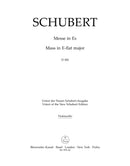| 作曲者 | Franz Schubert (1797-1828)・フランツ・シューベルト |
| タイトル | Messe in Es = Mass in E-flat major, D 950 (Cello part) |
| 出版社 | Bärenreiter・ベーレンライター |
| 楽器編成 | Soloists, Choir and Orchestra |
| 楽器編成(詳細) | Soprano solo, Alto solo, Tenor solo, Bass solo, Mixed choir (SATB), Flute, Oboe (2), Clarinet (2), Bassoon (2), Horn (2), Trumpet (2), Trombone (3), Timpani, Violin (2), Viola, Violoncello, Basso continuo |
| 品番 | 979-0006576012 |
| 校訂者 | Rudolf Faber |
| 言語 | ラテン語 • ドイツ語 |
| 形状 | 19 ページ |
| 出版年 | 2023年 |
| 出版番号 | BA 5576-82 |
| ISMN | 979-0006576012 |
We know relatively little about the genesis of Schubert’s Mass in E-flat major (D 950) which he completed in 1828, a few months before his death. The work was not performed during his lifetime and we can only speculate what might have caused the composer to write this Missa solemnis. In the preface to this volume of the New Schubert Edition, editor Rudolf Faber assembles all documented facts. Furthermore, he focuses on the accents, which are such a characteristic element of Schubert’s autograph scores, and explains how Schubert used them in a very differentiated manner, in particular in the Mass in E-flat major. In order to do justice to these subtle differences, the New Schubert Edition has introduced a new symbol: an accent which is flexible with regard to its length and which makes it possible to visualize Schubert’s sophisticated employment of emphasis and accentuation. The work is scored for large orchestra (without flutes), chorus, and one soprano as well as two tenors as soloists. In Schubert’s autograph the organ is not explicitly called for, but Ferdinand Schubert added an organ part for the posthumous premiere on 4 October 1829 at the Dreifaltigkeitskirche of Vienna Alservorstadt.



